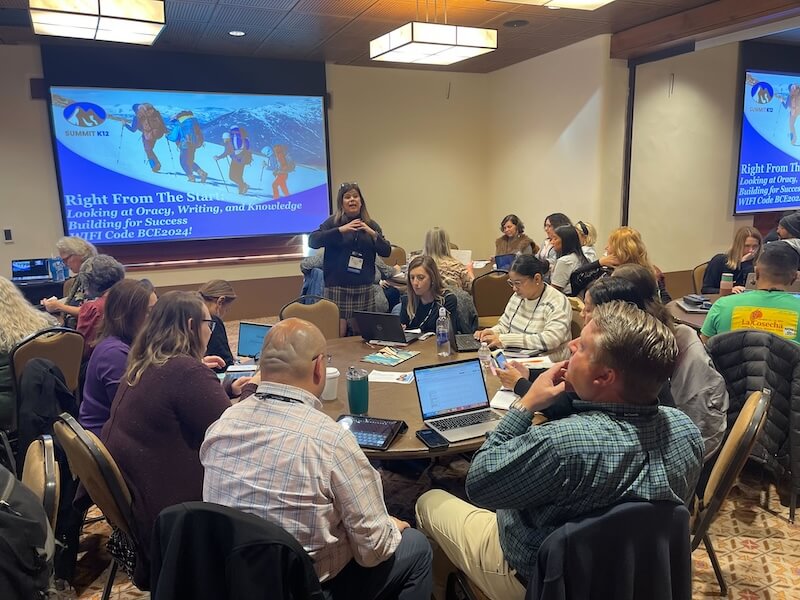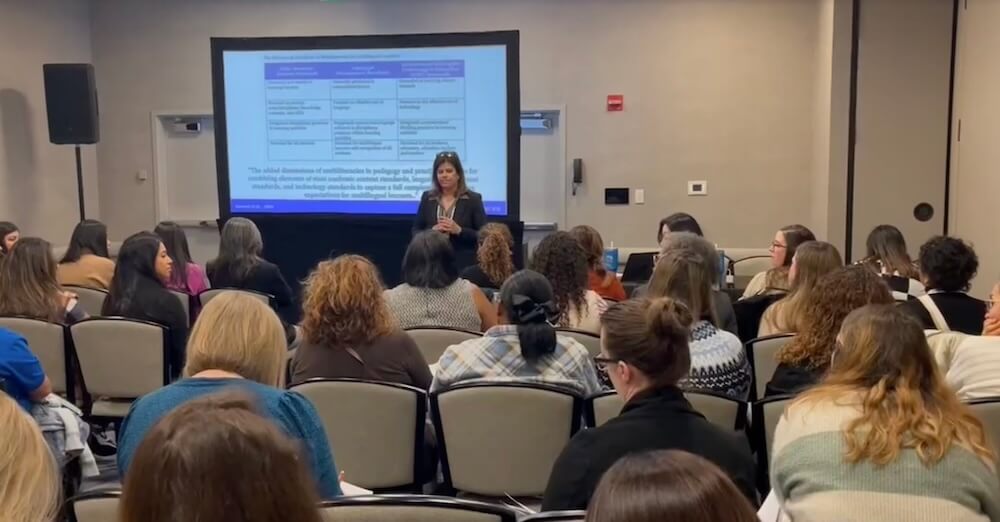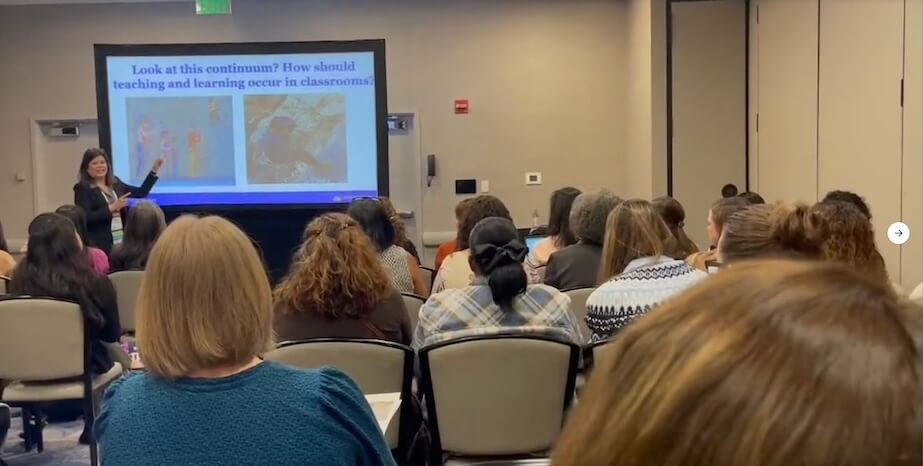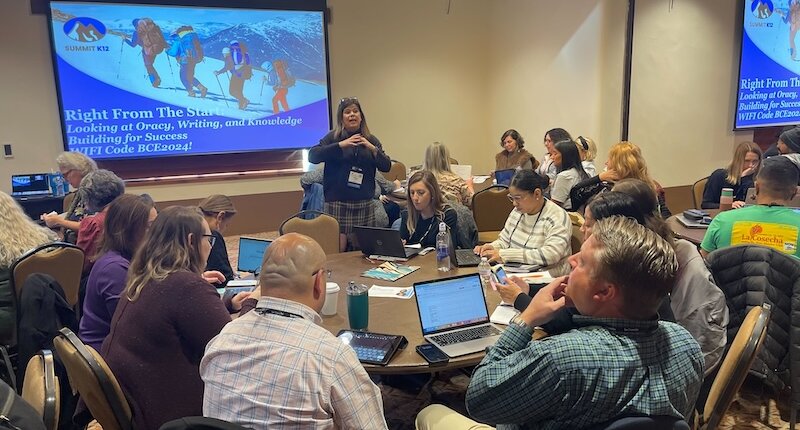
Building Systems of Opportunity in Language Acquisition: The Three Necessary Shifts (Part Two)
Written by: Amelia Larson, Chief Academic Officer, Summit K12.
In Shift 1 we challenged the familiar saying, “In K–3, children are learning to read, and in 4–12, they’re reading to learn.” Instead, we proposed a new paradigm: combining “Learning to Read” and “Reading to Learn” as early as possible for lifelong literacy success.
Background: Dual Language Learners (DLLs) are children (birth to age 8) from homes where a language other than (or in addition to) English is spoken. Approximately 7.4 million emerging bilingual children make up 33% of all U.S. children under six (Migration Policy Institute, 2021). More than 80% are children of color, and nearly 60% live in Spanish-speaking homes (Herrera et al., 2022). The numbers in some states are much higher: California, 59%, Texas, 49%, New Jersey, 47%, New Mexico, 44%, Nevada, 43%. These children constitute a significant proportion of elementary school students in the coming years. Given this demographic shift, early childhood education (ECE) must address their linguistic and educational needs with tailored research-based instruction.
Shift 2 challenges the traditional notion that decoding and word recognition should be taught in isolation. Instead, it advocates for a simultaneous and reciprocal approach, where early reading instruction develops strong word-reading skills, sustained language comprehension, and content-area learning. By integrating these components, young learners—especially DLLs—are better equipped to read with fluency, understanding, and confidence.
Key Challenges:
- The increase in uptake of code-based literacy instruction necessitates an expansion of our understanding of the implications regarding code-based skills for multilingual learners
- Assessments must reflect both decoding and language comprehension
- Early literacy programs must welcome and integrate home language skills
- Teachers must be equipped with strategies to support Dual Language Learners
The Science of Early Literacy
Early literacy development is deeply rooted in language. Research shows that oral language skills, such as vocabulary and phonological sensitivity, play a direct role in early reading (Brown, 2014; Storch & Whitehurst, 2002). Language comprehension is a strong predictor of reading success (Cervetti et al., 2020). Children with a strong oral vocabulary decode more easily and retain cognitive resources for comprehension (Byrnes, 2021).
Key Takeaways:
- Explicit and systematic instruction has an important place in core instruction
- Decoding alone is insufficient—meaning-making must be emphasized
- Oral language development is the foundation for reading comprehension
- DLLs require structured, engaging opportunities to build English vocabulary

Code-Based Instructional Materials: Key Design Features
At the English Learner Success Forum (2024), experts highlighted design challenges and opportunities for supporting multilingual learners. These recommendations ensure that multilingual learners develop both code-based skills and language comprehension in tandem.
Key Design Features:
Oral Language Development
Varied opportunities for conversation and articulation are essential to help students understand and use English confidently. This practice allows multilingual learners to become familiar with sounds that may not exist in their home language. Focused, repetitive articulation activities in meaningful contexts support the oral language skills necessary for strong language development and word recognition.
Cross-Linguistic Connections
Highlight cross-linguistic connections, capitalizing on students’ existing language knowledge to facilitate literacy development. By showcasing similarities and differences between home languages and English, instructional materials can empower students to leverage their linguistic assets for decoding.
Connecting Meaning to Code-Based Instruction
Include opportunities to connect phonemes and graphemes to the meaning of words. If children are unfamiliar with the words they encounter in print, decoding will not lead to comprehension. In the context of authentic reading and writing experiences and conversation, instructional materials can enhance students’ ability to purposefully apply their knowledge of letters and sounds to understand a text’s meaning. Without a focus on meaning, multilingual learners—especially those still building oral language skills in English—may struggle to create the neural connections necessary for word recognition.
Aligned Formative Assessments
Incorporate consistent formative assessments that identify students’ strengths and areas for growth to plan targeted support. These assessments help pinpoint where students may need additional support or practice, ensuring continuous growth through targeted practice opportunities.
Metalinguistic Awareness
Foster metalinguistic awareness by explicitly drawing students’ attention to sound patterns and relationships within words. This metacognitive approach empowers students to become independent readers and problem-solvers. This is especially important when multilingual learners are already literate in their home language and don’t need a full dose of phonics because of the overlaps and transference of these kinds of skills from one language to another.
Advanced Phonics and Morphological Patterns
Provide advanced phonics opportunities that encourage students to analyze patterns in words and strengthen their ability to decode multi-syllabic words and develop vocabulary. Instruction should provide opportunities for students to explore word morphology. Exploring prefixes, suffixes, and roots—especially from Latin and Greek—gives Spanish speakers and others with Latin-based language backgrounds a key advantage in understanding complex English words.
Fluency Development
Provide explicit fluency instruction that is informed by multilingual learners’ unique process of English language development. – alongside reading comprehension and oral language development. Recognize that fluency rates may vary due to cognitive load, cross-linguistic connections, and background knowledge gaps.

The Call to Action
A Comprehensive and Simultaneous Approach
“Given the absolute necessity of foundational word reading skills, it is tempting to think that instruction should begin with a focus on developing those and later turn to comprehension. However, research has supported a simultaneous, rather than sequential, model of reading instruction. Along with the development of phonological awareness, print concepts, and alphabet knowledge, young learners in preschool and early elementary school benefit from efforts to develop oral language comprehension, including efforts to develop oral comprehension of written language (i.e., through read-alouds).” – Cervetti, 2020; Swanson et al., 2011.
A comprehensive and simultaneous approach recognizes the need for DLLs to develop both broad language-based skills with related content knowledge to support meaning-making and learning the English language system and code-based skills that build on phonemic awareness, decoding skills, and encoding skills. A major challenge is presented when reading programs focus heavily on phonics-centered instruction and assessments with English-only measures for identifying instructional needs. This presents a serious problem as assessment results often inform instruction. DLLs are negotiating more than one language, so without a concerted effort to ensure that language comprehension is prioritized and becomes a standard component of assessments, the knowledge base on how to best support students’ language comprehension development – which directly impacts word recognition – will remain limited.
Instructional Considerations:
- Print concepts, phonological awareness, and alphabet knowledge should develop alongside oral comprehension.
- Read-alouds and discussions support listening comprehension before independent reading.
- Assessments should identify both language and decoding abilities to tailor instruction effectively.
Instructional Reciprocity: Maximizing Learning Time
“Rather than adding together completely separate skills, reading foundational skills function in harmony with one another as readers simultaneously apply information about print, phonemic awareness, phonics, and word recognition.” – Duke, 2023
A key challenge in early literacy education is the limited time available to address all the instructional goals, programs, and practices recommended by research. To tackle this issue, we advocate for integrating multiple foundational reading skills within the same instructional activities, combining language, reading, writing, speaking, and listening and blending literacy with content-area instruction. Traditional approaches teach skills sequentially—first phonemic awareness, then phonics, then fluency.
However, research reveals that literacy skills develop reciprocally:
- Decoding, spelling, and word reading boost phonemic awareness.
- Morphology and oral reading fluency strengthen decoding.
- Writing instruction improves reading comprehension.
By integrating skills, we reinforce learning and maximize instructional time. For DLLs, instructional reciprocity is essential. English’s deep orthography (though, through, bough) makes vocabulary knowledge crucial. Teaching word meaning alongside decoding helps students recognize patterns, leading to better comprehension.
Reading, writing, speaking, and listening are also interconnected—and should be taught together across subjects. Integrating literacy into science and social studies strengthens both language skills and academic knowledge (Kintsch, 1988).
Key Takeaways:
- Teach literacy skills together—connect phonemic awareness, phonics, and spelling.
- Use writing to support reading—it enhances phonics and word recognition.
- Pair vocabulary with decoding—especially for academic and low-frequency words.
- Blend literacy into content areas—it deepens comprehension and engagement.
By embracing instructional reciprocity, we create stronger, more efficient literacy instruction—giving all students, especially multilingual learners, the tools to succeed.
Building Systems of Opportunity
While models like the Simple View of Reading (Gough & Tunmer, 1986) provide a foundational understanding of reading development—highlighting the role of both decoding and language comprehension—research underscores their deep interdependence. Shift 2 reinforces this interdependence, emphasizing that literacy development is not just about learning to decode but also about integrating language, meaning, knowledge-building, and communication.
Rather than treating word recognition as an isolated skill, Shift 2 advocates for simultaneous and reciprocal instruction—an approach that builds strong decoding abilities within the context of rich language comprehension and content-area learning. This ensures students develop fluency, understanding, and confidence, equipping them to engage with texts in meaningful ways.
Shift 2 fosters Systems of Opportunity by supporting students to move beyond word recognition to actively construct meaning, collaborate with peers, and see language as a tool for deeper understanding.
“Literacy instruction should not just teach students how to read—it should inspire them to engage, think, and connect from the very start.”
Helpful Resources
Instructional strategies and materials selected for the classroom need to be effective, efficient and user-friendly for both teachers and DLLs. The goal is to balance instructional complexity with practical implementation to ensure high-impact learning experiences that don’t overwhelm teachers or students but drive meaningful learning outcomes.
Helpful resources include:
Early Literacy Development and Instruction for Dual Language Learners in Early Childhood Education, 2022 – Presents a research-based description of effective early literacy instruction and how literacy develops for dual language learners differ greatly from prevalent current tendencies to double-down on foundational skills instruction in the preschool years.
A Framework for Foundational Literacy Skills Instruction for English Learners, has four major parts—an overview of the research, a section envisioning optimal instruction, a summation of what teachers need to know about language, and considerations in selecting instructional materials.
Learners Guidelines for Improving English Language Arts Materials for English Learners were developed to provide specific research-informed EL strategies and best practices necessary for the simultaneous development of disciplinary knowledge, language and literacy for multilingual learners.
Instructional Materials for Code-based Reading Skills: Design Challenges and Opportunities for Multilingual Learners: Based on a review of instructional materials specifically for code-based skills, ELSF make recommendations around key design features to support multilingual learners’ early literacy development
References Available Upon Request
- Brown, C. (2014). Early Literacy Development in English Learners.
- Byrnes, J. P. (2021). Cognitive Development for Academic Achievement: Building Skills and Motivation. The Guilford Press. ISBN 9781462547135.
- Cabell, S. Q., & Hwang, H. (2023). Leveraging content-rich English language arts instruction in the early grades to improve children’s language comprehension. In S. Q. Cabell, S. B. Neuman, & N. P. Terry (Eds.), Handbook on the Science of Early Literacy (pp. 175-185) Guilford Press.
- Cervetti, G. (2020). How the Reading for Understanding Initiative’s Research Complicates the Simple View of Reading Invoked in the Science of Reading. Reading Research Quarterly. Wiley Online Library.
- Donnelly, S., & Kidd, E. (2021). The longitudinal relationship between conversational turn-taking and vocabulary growth in early language development. Child Development. https://doi.org/10.1111/cdev.13511
- Duff, F. J., & Hulme, C. (2012). The role of children’s phonological and semantic knowledge in learning to read words. Journal of Experimental Child Psychology, 113(1), 56-68.
- Dyson, H., Best, W., & Solity, J. (2017). Training mispronunciation correction and word meanings improves children’s ability to learn to read words. Journal of Experimental Psychology: General, 146(11), 1685-1705.
- Ehri, L. C. (2014). Orthographic mapping in the acquisition of sight word reading, spelling memory, and vocabulary learning. Scientific Studies of Reading, 18(1), 5-21.
- Erickson, L. C., & Thiessen, E. D. (2015). Statistical learning and language acquisition: Does the nature of the statistics matter? Developmental Science, 18(3), 299-311.
- Fillmore, L. W. (2017). Challenges in English Language Literacy for English Learners.
- Gough, P. and Tunmer, W. (1986). Decoding, reading, and reading disability. Remedial and Special Education, 7, 6–10.
- Kearns, D. M., & Al Ghanem, R. (2019). Knowledge of word-specific meanings facilitates multisyllabic word reading. Reading and Writing, 32(8), 1995-2022.
- Kearns, D. M., Rogers, H., Koriakin, T., & Al Ghanem, R. (2016). Semantic and phonological ability to adjust recoding: A unique correlate of word reading skill? Scientific Studies of Reading, 20(2), 147-162.
- Mesmer, H. A. (2020). Approaches to Literacy Instruction for ELs.
- Miles, K. M., & Ehri, L. C. (2019). Orthographic mapping of sight words in memory: What it is and how it functions in reading development. Scientific Studies of Reading, 23(1), 1-16.
- Ouellette, G., & Fraser, J. R. (2009). What exactly is a ‘sight word’? Orthographic and phonological knowledge in the acquisition of sight vocabulary. Reading and Writing, 22(2), 59-76.
- Parish-Morris, J., & Tager-Flusberg, H. (2007). Statistical learning and language: Toward a neurobiological understanding. In S. Vosniadou (Ed.), International Handbook of Research on Conceptual Change (pp. 237-254). Routledge.
- Ricketts, J., Nation, K., & Bishop, D. V. M. (2007). Vocabulary is important for some, but not all reading skills. Scientific Studies of Reading, 11(3), 235-257.
- Roberts, T. (2005). Articulation accuracy and vocabulary size contributions to phonemic awareness and word reading in English language learners. Journal of Educational Psychology, 97(4), 601–616. https://doi.org/10.1037/0022-0663.97.4.601
- Scanlon, D. M., & Anderson, K. L. (2020). Using context as an assist in word solving: The contributions of 25 years of research on the interactive strategies approach. Reading Research, Quarterly, 55(S1), S19 S34. https://doi.org/10.1002/rrq.335
- Shanahan, T. (2018, October 29). Appropriate beginning reading instruction for English learners? Shanahan on Literacy. https://www.shanahanonliteracy.com/blog/appropriate-beginning-reading-instruction-for-english-learners
- Share, D. L. (1995). Phonological recoding and self-teaching: Sine qua non of reading acquisition. Cognition, 55(2), 151-218.
- Storch, S. A., & Whitehurst, G. J. (2002). Oral Language and Code-Related Precursors to Reading: Evidence from a Longitudinal Structural Model.
- Taylor, J. S. H., Plunkett, K., & Nation, K. (2011). The influence of word meaning on word recognition. Cognition, 118(1), 45-61.
- Tunmer, W. E., & Chapman, J. W. (2012). The simple view of reading redux: Vocabulary knowledge and the independent components hypothesis. Journal of Learning Disabilities, 45(5), 453-466.
- Venezky, R.L. (1967). English orthography: Its graphical structure and its relation to sound. Reading Research Quarterly, 2(3), 75–105.https://doi.org/10.2307/747031
- Wang, H.-C., Castles, A., Nickels, L., & Nation, K. (2013). Context and word meaning influences on learning to read words. Journal of Experimental Psychology: Learning, Memory, and Cognition, 39 (2), 405-416.







